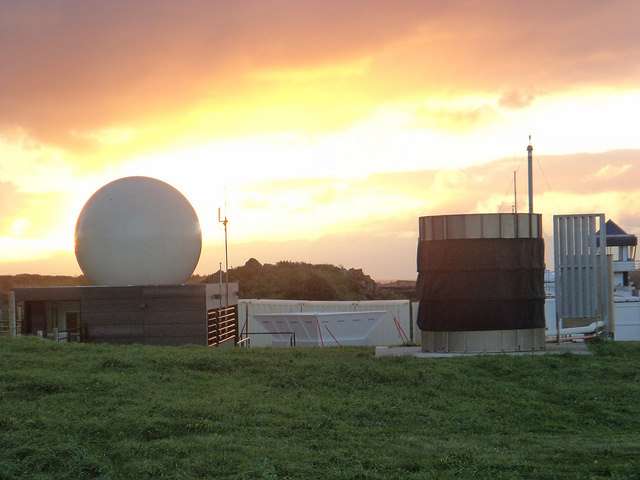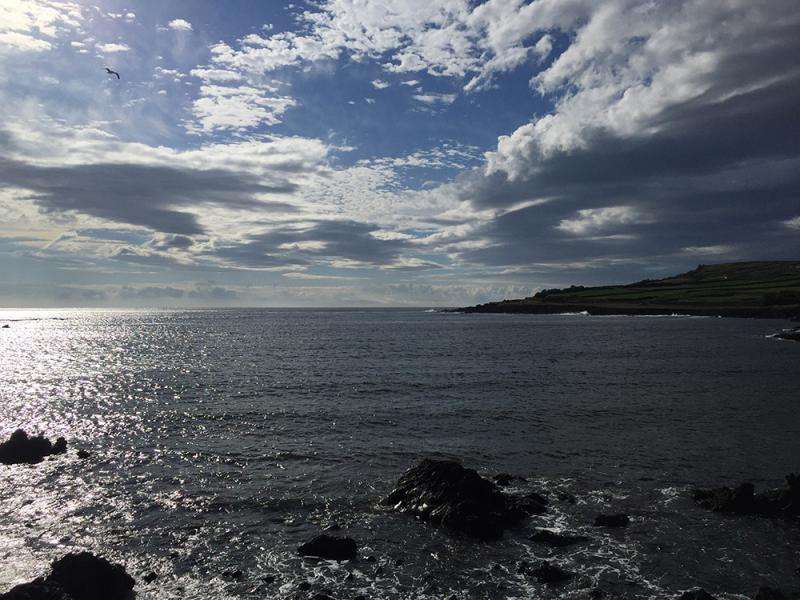During the ACE-ENA campaign, ground instruments at the Eastern North Atlantic atmospheric observatory on Graciosa Island will coordinate with those aboard the G-1 research aircraft. To the left is the sphere-like X-band scanning ARM precipitation radar, a second-generation ARM radar that will see its first use during a campaign. Credit: US Department of Energy
Low clouds populate the first two kilometers of the atmosphere. Cumuliform clouds heap high and are made from columns of fast-rising air. Stratiform are sheet-like and show little vertical air movement.
Since low clouds are globally abundant, they impact the planet's radiation energy budget and its climate to a vast degree. Part of that impact is from the influence low clouds have on the Earth's albedo, a measure of how much solar energy is radiated back into space.
Yet low clouds are poorly represented in earth system models, a great source of uncertainty in climate simulations. Gaps in observational data are largely to blame. In remote marine regions, for instance, low clouds—called Marine Boundary Layer (MBL) clouds—are hard to measure for their condensate loading, for their radiative properties, and for how they are organized on scales of up to 100 kilometers.
Another source of uncertainty is how low clouds respond to changes in the aerosols—the suspended solid or liquid particles—within them. In aerosols, both natural and anthropogenic (human) perturbations can affect how clouds scatter or absorb radiation, how they create precipitation, and how long they live.
Starting this June, a new research campaign sponsored by the U.S. Department of Energy (DOE) will address such modeling uncertainties. The Aerosol and Cloud Experiments in Eastern North Atlantic (ACE-ENA) campaign, an attempt to fill in some observational data gaps, is slated to run in two 40-day phases—one in June and July this year, and one in January and February of 2018.
The campaign's operational center is Eastern North Atlantic (ENA), a fixed atmospheric observatory on Graciosa Island in the Azores west of Portugal. It's managed by the Atmospheric Radiation Measurement (ARM) Climate Research Facility, a DOE science user facility with three fixed observatories in climate-sensitive regions of the globe.
While examining key cloud and aerosol processes in a remote marine setting, ACE-ENA scientists will also address a range of science objectives. They will investigate budgeting and seasonal variations in cloud condensation nuclei; the microphysical and macrophysical structures within MBL clouds; how environmental air mixes—entrains—into currents and clouds; and how well present-day algorithms deal with new airborne measurements of turbulence, liquid water content, and the size of droplets from both drizzle and clouds.
From above and below, synergy
Combining ground and aircraft observations creates a fruitful synergy at the heart of ACE-ENA measurements, says campaign principal investigator Jian Wang, an atmospheric scientist at Brookhaven National Laboratory (BNL) in New York. "You get a more complete picture of aerosols and clouds."
Ground-based fixed instruments run continuously over a long time, he says. Aircraft cover shorter time frames, but pull in more detailed information on interconnected aerosol and cloud processes related to trace gases, drizzle, and atmospheric thermodynamics. Aerial measurements, says Wang, also help validate those from the ground.
Similar campaigns in pursuit of data on low marine clouds have been executed off the coast of Chile and California, he says, but ACE-ENA will be the first to significantly coordinate air and ground observations in the eastern North Atlantic.
One measure of the campaign's novelty and promise is the number of scientists who not only signed on as co-investigators and collaborator but who will appear on site during the campaign, even just to help with weather forecasting. "Quite a good number of people will show up," says Wang. He is a long-time ARM data user and is active on committees and working groups for the DOE's Atmospheric System Research, which coordinates with the ARM Facility on gathering and analyzing cloud and aerosol data.
ACE-ENA will be the first campaign to significantly coordinate air and ground observations in the eastern North Atlantic in pursuit of data on low marine clouds. Credit: US Department of Energy
During ACE-ENA, a lot of the data scientists need are best collected from aerial platforms. Doing the heavy lifting will be ARM's Gulfstream-159 (G-1) research aircraft, the centerpiece of the ARM Aerial Facility (AAF) managed by the Pacific Northwest National Laboratory (PNNL) in Richland, Washington. It will carry 55 instrument systems during intricately programed flights of spirals and legs.
In spirals, the aircraft flies up and down through a range of altitudes to gather vertical profiles of aerosols and clouds. Legs are flown at multiple altitudes to take in data from below, within, and above cloud cover. Leg flight patterns provide detailed data pictures of the vertical distributions and horizontal variations of low clouds and aerosols.
Legs are also sometimes flown in the free troposphere, high above boundary layer clouds. Data from this atmospheric region will help scientists understand if the observed aerosol particles are coming from local sources, or are being transported over long distances.
The experiment's 60×60-kilometer flight grids will focus on ENA's Graciosa Island ground site. Most of the airborne tracks will be within the range of ENA scanning radars, enabling scientists to get the kind of detailed microphysical information needed to evaluate the algorithms used to retrieve cloud information from the radar observations.
For good data, lots of flight time
The G-1, a twin-turboprop airborne research laboratory, will fly two 40-day missions during the two-phase campaign—about 20 flights each time, for as much as four hours at a time. "We will fly as much as we can," says AAF manager Beat Schmid, an atmospheric scientist at PNNL.
During ACE-ENA, the G-1 will be based 90 kilometers from Graciosa, at a joint U.S.-Portugal airbase called Lajes, on the island of Terceira.
Meanwhile, by April 20 the G-1 instrument package will have been fully integrated and tested at an airport not far from PNNL, a process that started February 10. Then about half of that gear had to be packed and shipped separately, says Schmid, "so we have enough fuel" to cross the Atlantic from a stopover in St. John's, Newfoundland. Once at Lajes, on June 15, both plane and instruments will be reintegrated.
On board, in a first for a DOE aircraft, will be a Holographic Detector for Clouds (HOLODEC), a wing-mounted device that takes "incredibly detailed" multi-dimensional pictures of cloud droplets, says Schmid. "It's not an image in a conventional sense." The process is so data-intensive, he adds, that the resulting huge files—too big for the Internet—have to be shipped back to ARM on disks.
The HOLODEC provides information about how cloud droplets interact on microphysical scales. It will also help ACE-ENA scientists study how the size distribution of cloud droplets is affected by mixing cloudy air with drier, non-cloudy air.
The G-1 aircraft will also be flying the fast integrated mobility spectrometer (FIMS), a unique instrument developed at BNL that is used to measure both aerosol concentrations and aerosol particle size distribution.
The instruments of ACE-ENA, on the ground and in the air, all share one collaborative mission—to get the best data ever on the climate-consequential low clouds in a remote marine setting.
"If you get them wrong in the models," says Schmid, "it has a huge impact."
Provided by US Department of Energy

























